Military Aerial Tankers
The Concept of Aerial Refueling
Military Tankers |
Aerial refueling allows a tanker aircraft to transfer fuel to a receiving aircraft, which can then remain airborne longer, and extend its range and time on station. The concept was originally employed before World War II on a very limited scale. After World War II it began to be used to extend the range of strategic bombers and is today used extensively in large-scale military operations.
The two main types of refueling systems are probe-and-drogue, which is simpler to adapt to existing aircraft, and the flying boom, which offers faster fuel transfer, but requires a dedicated boom operator station.
U.S. tanker aircraft have their model type beginning with the letter "K".
An Early Air Refueling Success: The First Round-the-World Non-Stop Flight
One of aviation's most historical flights involved the B-50 and took place in early 1949, the first non-stop around the world flight. The flight was possible due to the aerial refueling.
The aircraft was B-50A-5-BO, S/N 46-010, named "Lucky Lady II", assigned to the 43rd Bomb Group.
The B-50 took off from Carswell Air Force base in Fort Worth, Texas on February 26, 1949, and headed east. In addition to three pilots onboard, the flight was double-crewed, with each man being relieved at 4-to-6 hour intervals.
The mission was considered secret, and flight plans disguised the actual route. If the flight was not successful, the Air Force did not want, or need, the negative publicity that would be forthcoming.
The plane was refuelled four times during daylight hours in the air by KB-29M tanker planes of the 43rd Air Refuelling Squadron. The refuelling locations were over the Azores, Saudi Arabia, the Philippines and Hawaii. The KB-29 flew above the B-50 and lowered a cable and drogue, as shown in the Air Force photo below.
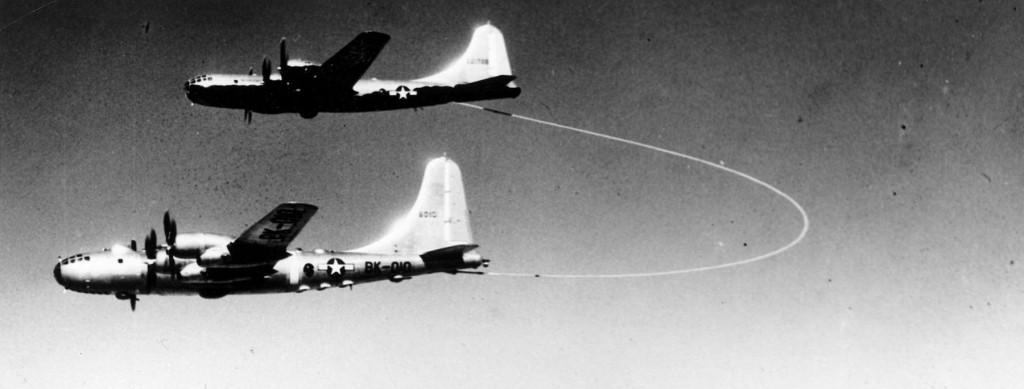 |
KB-29 Aerial Tanker
| KB-29 Superfortress of the 27th Air Refueling Squadron, Bergstrom AFB, Texas (USAF Photo) |
 |
Two tanker versions of the B-29 Superfortress were developed and produced: KB-29M and KB-29P. The B-29 played an important role in developing the effective use of aerial refueling during the late 1940s.
The first aircraft produced for aerial refueling was the KB-29M tanker which used a flexible hose approach.
A more refined system was used in the KB-29P, involving a rigid flying boom system. The boom was mounted on the aftmost end of the KB-29P, and had two small wings. This approach would later be used in other Air Force tankers, including the KB-50, KC-97, KC-135 and KC-10.
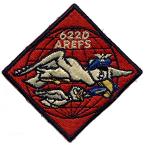 |
KB-50 Aerial Tanker
A variant of the B-50 Superfortress was the KB-50, used for air-to-air refueling. KB-50s featured reinforced outer wing panels, the necessary equipment to air refuel simultaneously three fighter-type aircraft by the probe and drogue method.
The first KB-50 flew in December 1955 and was accepted by the USAF in January 1956.
A number of units operated the KB-50, including the 622nd Air Refueling Squadron based at England Air Force Base ... see patch above.
The tanker and WB-50 weather reconnaissance versions of the B-50 remained in service until 1965.
Boeing KB-50J, S/N 49-0389, when it was on display at MacDill AFB, Tampa, Florida. It was moved in 2018 to the Air Mobility Command Museum at Dover AFB in Delaware, where it is undergoing restoration (By Valder137 [CC BY 2.0 (http://creativecommons.org/licenses/by/2.0)], via Wikimedia Commons) |
Boeing KB-50J Superfortress S/N 0-80114, in flight |
 |
A U.S. Air Force Boeing KB-50D Superfortress (S/N 48-123) of the 622d Air Refueling Squadron (4505th ARW) carrying out first triple-point refuelling operation with three North American F-100C Super Sabres (54-1825, 53-1774, 54-1848) of the 451st Tactical Fighter Squadron (322nd TFW), 1956. |
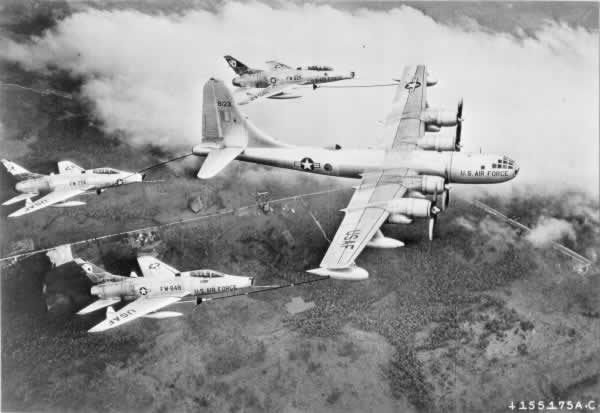 |
Boeing KC-97
Boeing KC-97L Stratotanker S/N 52-2630 at the Museum of the US Air Force in Dayton, OH
The C-97 was designated KC-97 when it was equipped with the Boeing-designed flying boom for aerial refueling. The boom had controls so the boom operator could literally "fly" the end of the boom from the KC-97 tanker into the receiving airplane.
There were 888 C-97s built between 1947 and 1958. Of those, 219 were adapted as KC-97E and F tankers and 592 were KC-97G models. The KC-97Gs had additional 700-gallon external fuel tanks under each wing and could dispense 8,513 gallons of fuel while carrying 96 troops.
To keep its tankers compatible with its newer high performance jet aircraft, the USAF gradually replaced the slower KC-97 planes with Boeing KC-135 jet tankers after 1956.
However, some modified KC-97s continued flying in other roles. In 1964 some of them received two jet engines. The increased speed of these KC-97L aircraft made them more compatible with high performance jet aircraft, and they served primarily with the Air National Guard. The USAF retired its last C/KC-97 in 1973, but other planes remained in use with the Air Force Reserve and Air National Guard as tankers or search and rescue aircraft.
KC-97L, S/N 53-298, Robins Air Force Base, Georgia |
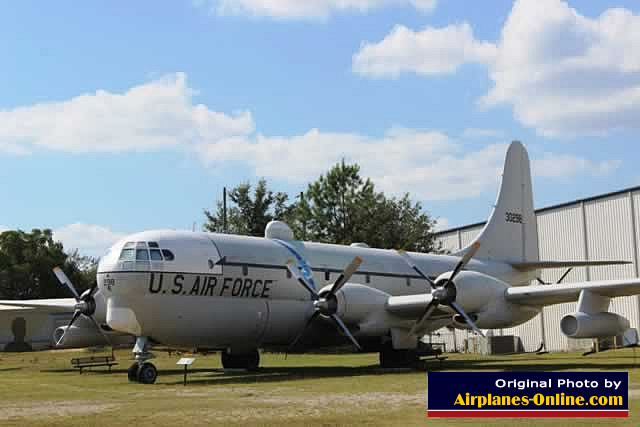 |
Boeing KC-97L Stratotanker, S/N 030240, at the Global Power Museum, Barksdale AFB, Louisiana |
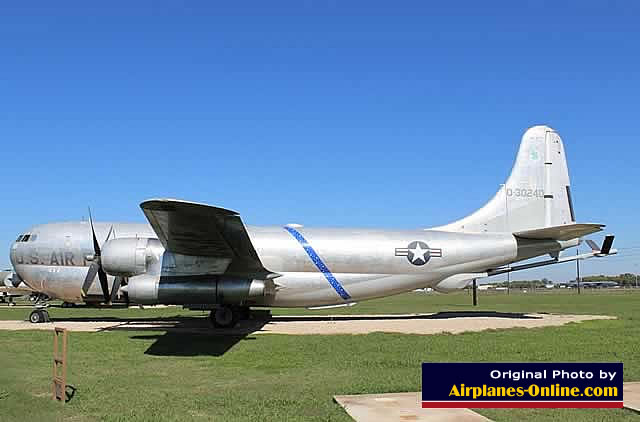 |
KC-97 Stratotanker, S/N 030240, at the Global Power Museum |
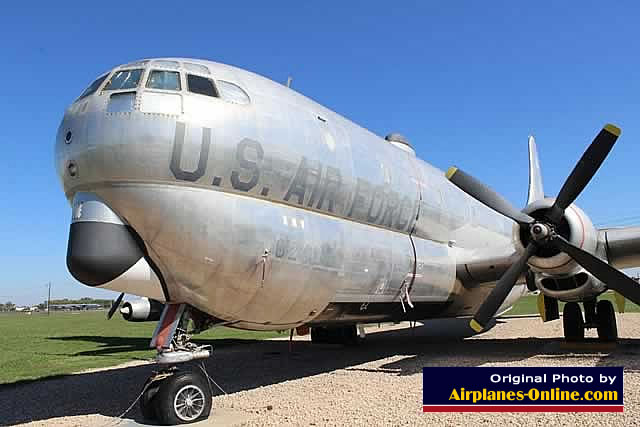 |
Front fuselage view of the U.S. Air Force KC-97 Stratotanker, S/N 030240 |
 |
Tail section and refueling boom on the KC-97 Stratotanker, S/N 030240, Global Power Museum |
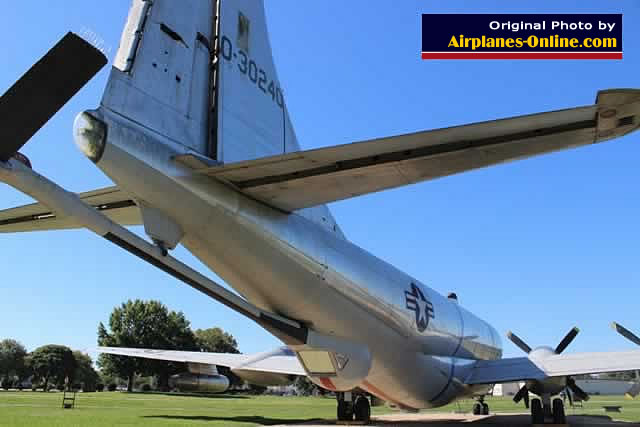 |
KC-97 Stratotanker, S/N 0-30363, on display at the March Field Air Museum in California |
 |
U.S. Air Force KC-97G, S/N 53-0198, Strategic Air Command and Space Museum, Ashland, Nebraska |
 |
U.S. Air Force KC-135 Stratotanker
 U.S.A.F Boeing KC-135 Stratotanker U.S.A.F Boeing KC-135 Stratotanker |
The KC-135, evolved from the Boeing Dash-80 prototype, was the U.S. Air Force's first jet-powered refueling tanker, introduced in 1957. It replaced the KC-97.
The KC-135 is similar in appearance to the commercial 707, but has a narrower fuselage and is shorter than the 707.
Variants of the C-135 airplane were utilized for other purposes, including presidential aircraft, such as the VC-137, also known as the C-137 Stratoliner.
The next generation Air Force tanker was the KC-10 Extender, to be followed in 2017 by the Boeing KC-46A which is based on the Boeing 767.
Boeing would eventually build over 800 of the C-135 series aircraft.
KC-135 Photos from the Airplanes Online Archives
KC-135E Stratotanker, S/N 57-1510, Hill AFB Museum, Ogden, Utah |
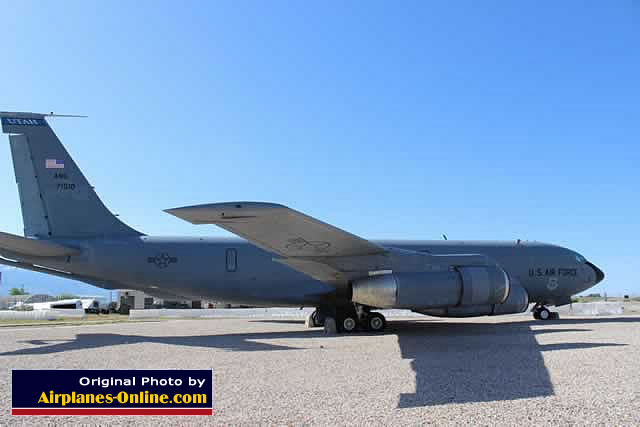 |
KC-135 Stratotanker S/N 63595 at the Global Power Museum, Barksdale AFB in Bossier City, Louisiana |
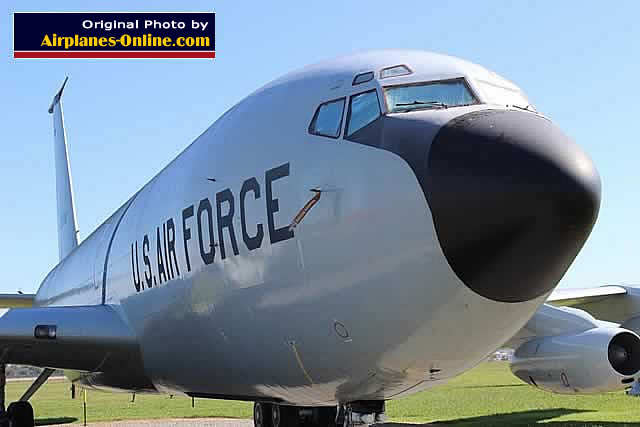 |
U.S. Air Force EC-135, S/N 10262, at the entrance to Ellsworth Air Force Base |
 |
KC-135 Photographs by Our Friends and Supporters
KC-135 Stratotanker at Eielson Air Force Base near Fairbanks, Alaska (photo by Michael Hoschouer) |
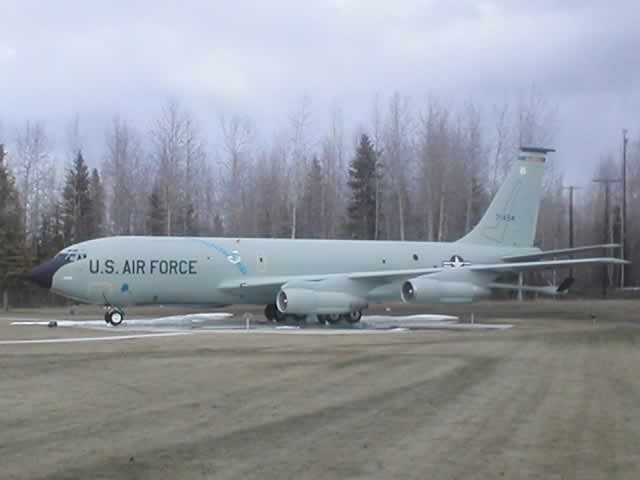 |
KC-135R Stratotanker of the 97th Air Mobility Wing at the 2014 Cannon AFB Air Show, Clovis, New Mexico (photo by Andrew Hersey) |
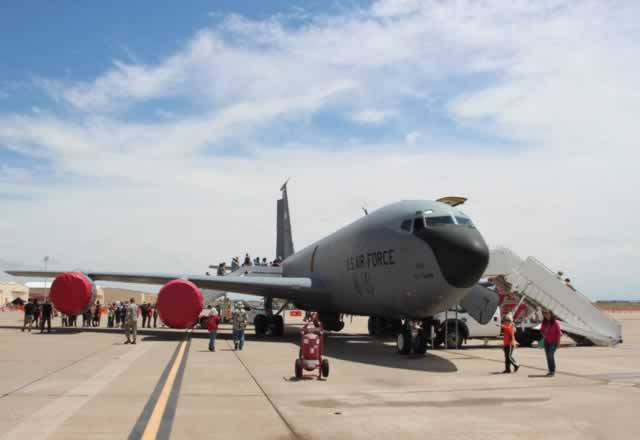 |
McDonnell-Douglas KC-10 Extender of the U.S. Air Force
A military aerial tanker version of the DC-10 commercial airliner was developed for the United States Air Force, and operated as the KC-10 Extender. It employs a mixed hose-and-drogue and flying-boom refueling system, and can refuel military aircraft of the U.S. Air Force, Navy and Marine Corps. It has twice the refueling capacity of the Air Force KC-135 Stratotanker.
McDonnell-Douglas (now Boeing) delivered a total of 60 KC-10 Extenders to the Air Force between 1981 and 1988.
In July of 2020 the Air Force retired KC-10 tail #86-0036, sending it to the 309th Aerospace Maintenance and Regeneration Group (AMARG) at Davis-Monthan AFB in Tucson. It had been on active duty at Joint Base McGuire-Dix-Lakehurst, New Jersey. This was the first of other KC-10s which are slated for retirement.
| Shown below is a KC-10 Extender of the United States Air Force during in-flight refueling operations with a F-22 Raptor (Photo courtesy of the US Air Force) |
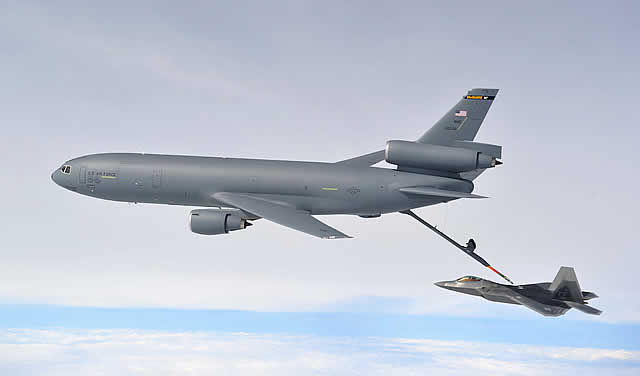 |
KC-10 Extender Storage and Reclamation at AMARG
| The first USAF KC-10 Extender, S/N 86-0036, arrives at the 309th AMARG at Davis-Monthan AFB in Tucson, Arizona, on July 13, 2020. The last KC-10 was delivered on Thursday, September 26, 2024, and is in the queue at AMARG awaiting preservation and storage. (Photo by USAF 309th AMARG) |
 |
| KC-10 Extenders at AMARG in storage and reclamation (Photo by USAF 309th AMARG) |
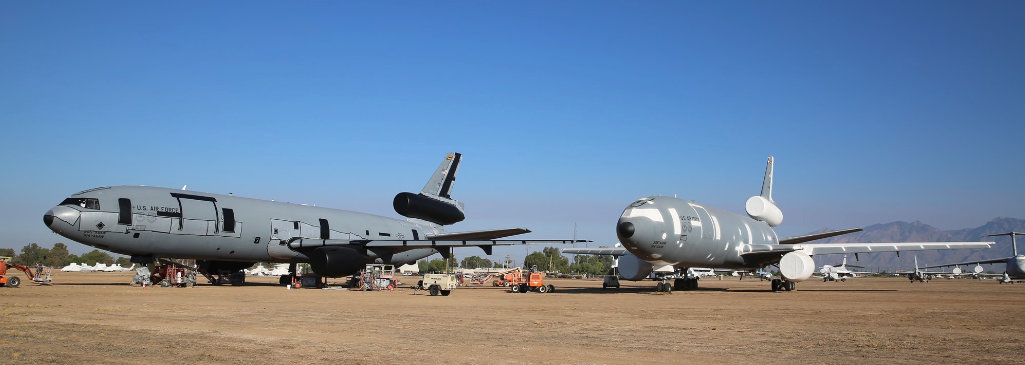 |
KC-46 Pegasus Aerial Tanker
| Boeing Delivers First KC-46A Tanker to Altus AFB Boeing News - 2/8/2019 |
Boeing Delivers First Two KC-46A Pegasus Tankers to U.S. Air Force at McConnell AFB |
The KC-46, derived from Boeing’s commercial 767 airframe, is built in Boeing’s Everett, Washington, facility. Boeing designed the KC-46 not only to perform as an aerial tanker, but also to carry passengers, cargo and patients.
The aircraft had its first test flight in September of 2015. In January of 2019, the U.S. Air Force accepted the first KC-46A Pegasus, with delivery to be made to McConnell Air Force Base, in Wichita, Kansas.
During extensive flight testing, six KC-46 completed more than 3,800 flight hours and offloaded more than four million pounds of fuel to A-10, B-52, C-17, KC-10, KC-135, KC-46, F-15E, F-16 and F/A-18 aircraft.
Boeing has a contract for 52 of an expected 179 tankers for the Air Force. Beyond the first aircraft that was accepted, nine aircraft are undergoing customer acceptance testing with the remaining aircraft of the contracted amount in production.
| USAF KC-46A at the Boeing plant in Seattle (photo courtesy of the Boeing Company) |
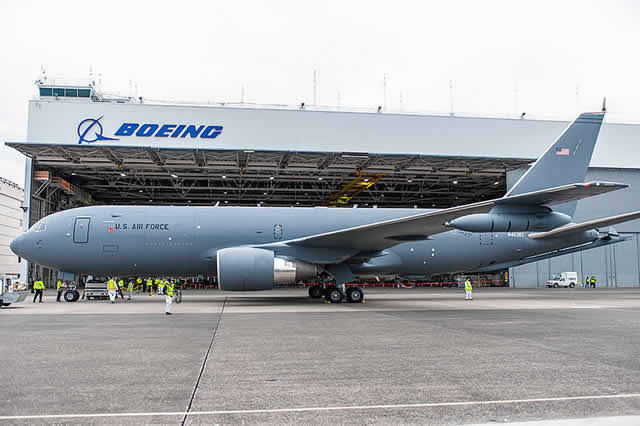 |
| Shown below is a KC-46A Pegasus of the United States Air Force (Photo courtesy of the Boeing Company) |
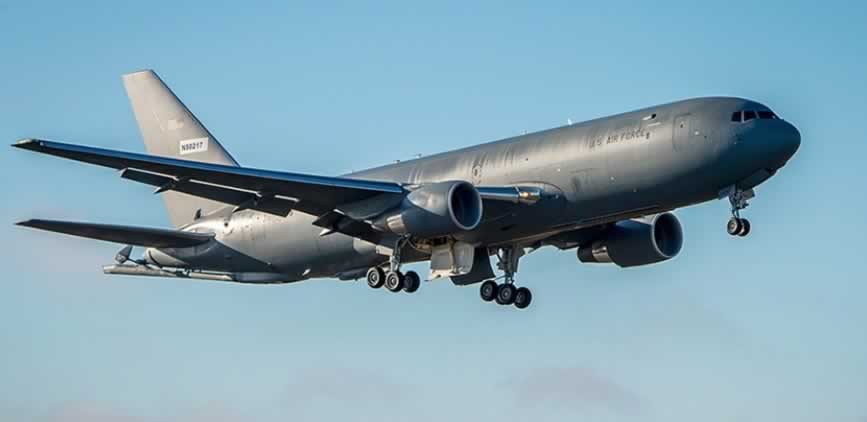 |
| KC-46A Pegasus of the United States Air Force (left) during in-flight refueling operations with a KC-10 Extender (right) (Photo courtesy of the Boeing Company) |
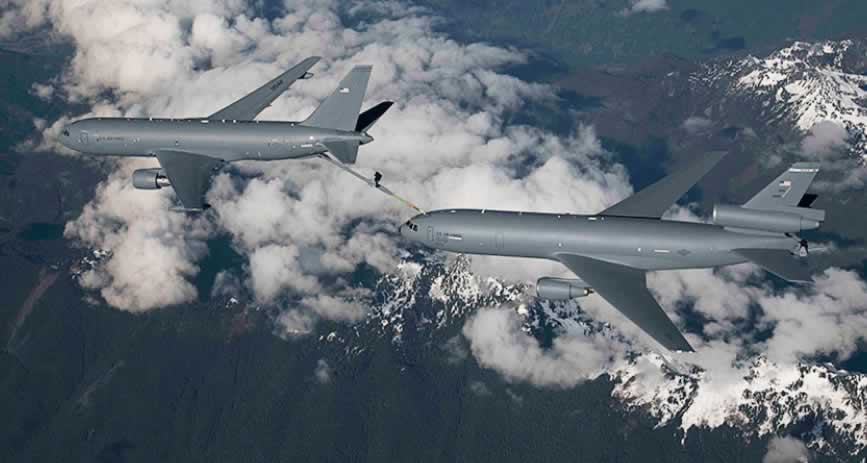 |
KC-130 Aerial Tanker
The KC-130 is a multi-role, multi-mission tactical tanker/transport which provides the refueling support required by the U.S. Marine Corps for its aircraft. This versatile asset provides in-flight refueling to both tactical aircraft and helicopters.
The KC-130J is the latest C-130 Hercules variant operated by the Marine Corps, with 48 delivered out of 79 ordered. It replaced older KC-130F, KC-130R, and KC-130T variants.
| KC-130J of the Marine Aerial Refueler Transport Squadron-352 (Photo courtesy U.S. Marine Corps) |
 |
Airbus A330 Multi Role Tanker Transport (MRTT)
|
The Airbus A330 Multi Role Tanker Transport (MRTT) is an aerial refuelling tanker aircraft based on the civilian Airbus A330-200.
The A330 MRTT cabin can be modified to carry up to 380 passengers in a single class configuration, allowing a complete range of configurations from maximised troop transport to complex customisation suitable for VIP and guest missions.
The MRTT can also be configured to perform Medical Evacuation (Medevac) missions; up to 130 standard stretchers can be carried. The main deck cargo configuration allows carriage of standard commercial containers and pallets, military, ISO and NATO pallets.
Standard commercial A330-200s are delivered from Airbus Final Assembly Line in Toulouse, France to Airbus Military Conversion Centre in Getafe, Spain for fitting of refuelling pods, booms and and military avionics.
A total of 12 nations have placed firm orders for approximately 60 aircraft, of which 42 had been delivered by the end of January 2020.
| French Air Force Airbus A330 MRTT Phénix, Registration F-UJCG (Photos by DELEHELLE Eric) |
|
 |
|
 |
|
| Airbus 330 MRTT of the UAE Air Force, No. 1302 (Photos by DELEHELLE Eric) | |
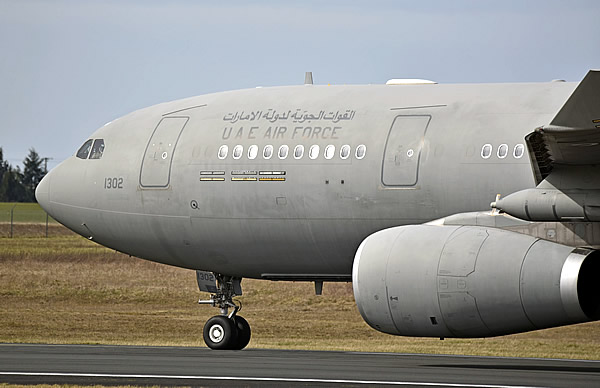 |
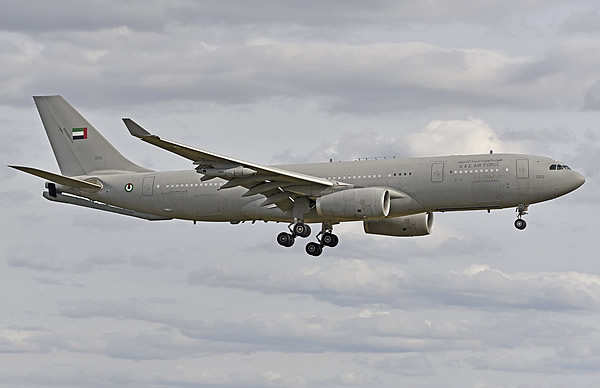 |
Future A330 MRTT, MSN 1857, for Singapore Air Force, Registration EC-335, arriving for anti-corrosion paint in 2018 (Photo by DELEHELLE Eric) |
 |



